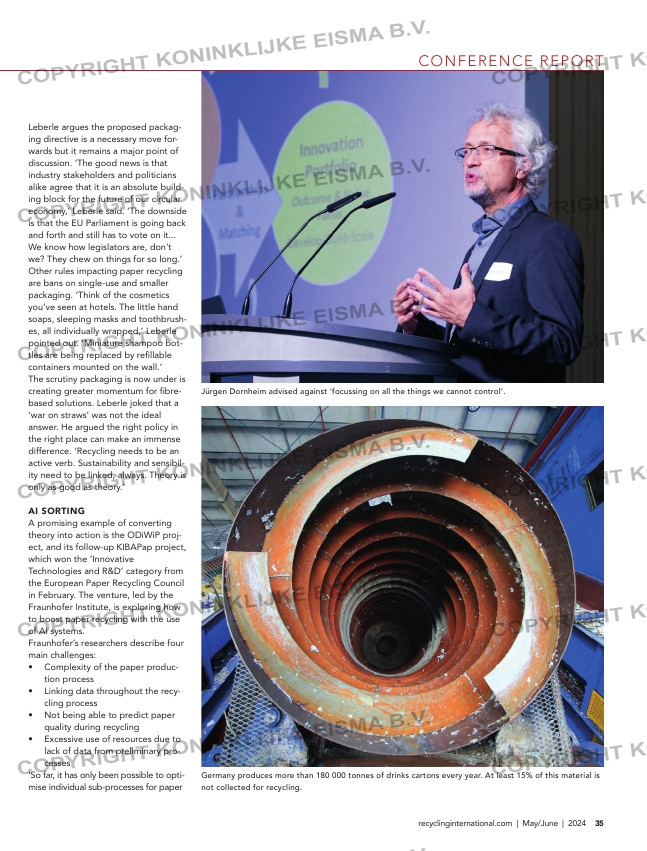Page 35 from: What’s inside?

CONFERENCE REPORT
35recyclinginternational.com | May/June | 2024
Leberle argues the proposed packag-
ing directive is a necessary move for-
wards but it remains a major point of
discussion. ‘The good news is that
industry stakeholders and politicians
alike agree that it is an absolute build-
ing block for the future of our circular
economy,’ Leberle said. ‘The downside
is that the EU Parliament is going back
and forth and still has to vote on it…
We know how legislators are, don’t
we? They chew on things for so long.’
Other rules impacting paper recycling
are bans on single-use and smaller
packaging. ‘Think of the cosmetics
you’ve seen at hotels. The little hand
soaps, sleeping masks and toothbrush-
es, all individually wrapped,’ Leberle
pointed out. ‘Miniature shampoo bot-
tles are being replaced by refillable
containers mounted on the wall.’
The scrutiny packaging is now under is
creating greater momentum for fibre-
based solutions. Leberle joked that a
‘war on straws’ was not the ideal
answer. He argued the right policy in
the right place can make an immense
difference. ‘Recycling needs to be an
active verb. Sustainability and sensibil-
ity need to be linked, always. Theory is
only as good as theory.’
AI SORTING
A promising example of converting
theory into action is the ODiWiP proj-
ect, and its follow-up KIBAPap project,
which won the ‘Innovative
Technologies and R&D’ category from
the European Paper Recycling Council
in February. The venture, led by the
Fraunhofer Institute, is exploring how
to boost paper recycling with the use
of AI systems.
Fraunhofer’s researchers describe four
main challenges:
• Complexity of the paper produc-
tion process
• Linking data throughout the recy-
cling process
• Not being able to predict paper
quality during recycling
• Excessive use of resources due to
lack of data from preliminary pro-
cesses
‘So far, it has only been possible to opti-
mise individual sub-processes for paper
embracing change, which comes with
new risks, can be scary. But time
doesn’t stand still. The world and
everyone in it are changing at a rapid
pace.’
FOREVER GREEN
Procter & Gamble joined the
4EverGreen Alliance wanting to con-
tribute to a more circular world. The
organisation now represents more
than 110 members from the European
fibre-based packaging industry.
Together, they have formed technical
working groups, aimed at raising
awareness and creating new tools and
solutions to boost sustainable packag-
ing.
Ultimately, 4EverGreen seeks a 90%
recycling rate for fibre-based packag-
ing in Europe by 2030. Its outreach
programmes have involved many big
players, including Apple, Amazon,
BASF, DS Smith and Mondi. The alli-
ance’s efforts won a prestigious
‘Information and Education’ award
from the European Paper Recycling
Council in February.
Proctor & Gamble’s Dornheim wel-
comed the impending arrival of the
Packaging & Packaging Waste
Regulation (PPWR). He hoped it would
be the foundation of ‘real change’ and
more unity across the industry. ‘As a
producer, we realise we need to be on
board, too. We can’t stare ourselves
blind at our bottom line. We have to
expand our thinking and keep pushing
for innovation.’
One thing was clear to Dornheim:
‘Chance doesn’t happen if one compa-
ny is paving the road alone. All of us,
recyclers and producers alike, have our
work cut out.’
STEPS FORWARD
‘It’s taken quite a long time but prog-
ress is underway,’ commented Ulrich
Leberle, raw materials director at the
Confederation of European Paper
Industries. ‘For one, the efforts of the
paper recycling sector are finally being
recognised. Much deserved.’ He sees
PPWR as a logical follow-up step to
established recycling legislation such
as the WEEE and Battery directives.
Jürgen Dornheim advised against ‘focussing on all the things we cannot control’.
Germany produces more than 180 000 tonnes of drinks cartons every year. At least 15% of this material is
not collected for recycling.
30-31-32-34-35-36_globalpapertrends.indd 35 24-04-2024 14:09



